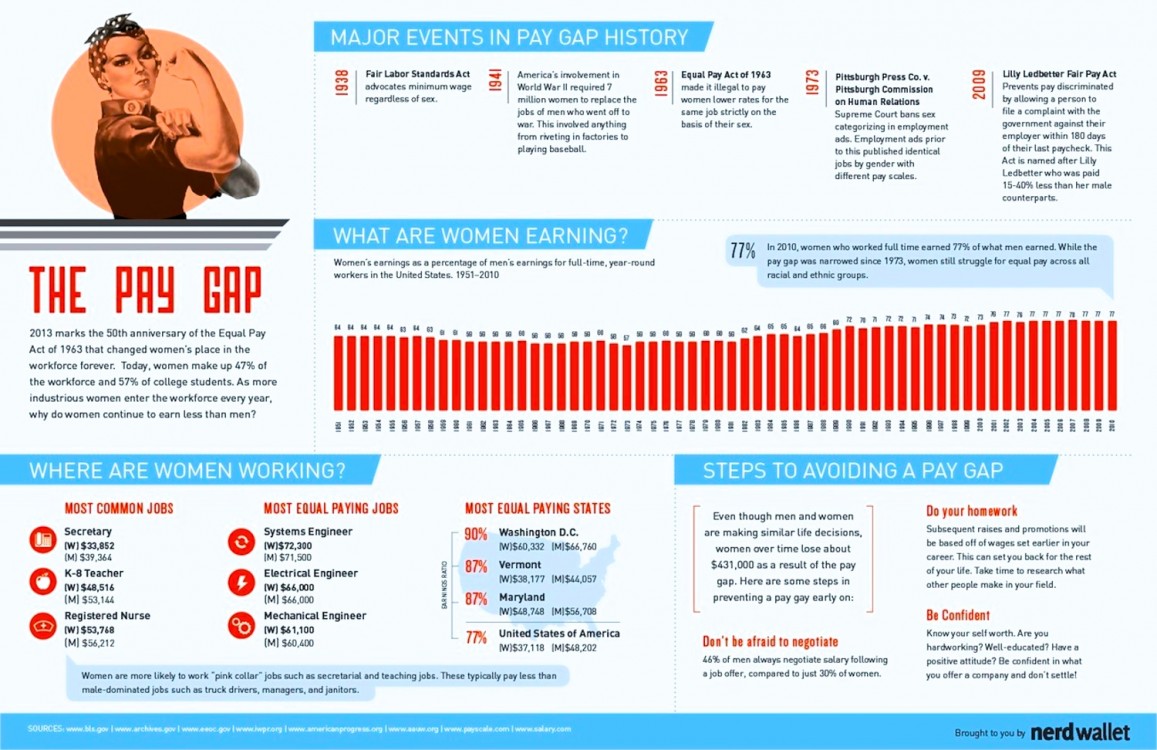
Raising the minimum wage is, for the most part, framed as a matter of economic justice. But it also concerns feminism.
From Walmart moms who work at the retail giant to domestic workers, women are significantly overrepresented in low-wage jobs. This chronic concentration of women in low-paying positions is one of the primary reasons for the lingering pay gap between the sexes. Currently, 55 percent of workers who are stuck making $7.25 per hour — the federal minimum wage — are women. Even those who earn slightly more are often still mired in poverty.
As Amy Traub recently wrote, retail sales is the largest private employment sector in America. These are jobs disproportionally held by women and earn them $10.58 an hour, on average (more than $4 behind than their male counterparts). In addition, they have other liabilities. For example, 19 percent report being fired for missing work to tend a sick child.
Beyond retail, a recent report published by the White House shows that women are heavily overrepresented in the food service sector. They account for 72 percent of tipped workers, whose federal minimum wage has been stuck for decades at $2.13 per hour. Ninety percent of domestic workers are women; these workers are excluded from our country’s wage and hour laws, meaning their employers aren’t even required to pay them the minimum wage.
For all these reasons, women have the most to gain from campaigns to raise the pay floor in our economy. Traub recently released a study of the 1.3 million women employed in low-wage retail jobs who are living in or near poverty and found that even a modest wage increase, to $25,000 per year, would move almost half a million of them out of poverty.
Women On the March
By speaking out to promote living wages and by advocating for their families, female activists are fighting to end poverty and sexism. Walmart Moms, a group of self-identified mothers who work as Walmart associates and who have banded together to demand better conditions, led a demonstration at the company’s June 6 annual shareholders’ meeting. The moms highlighted the poor treatment of women and demanded reasonable wages and hours, which the retail giant can easily afford.
It’s a brave move. Walmart is notorious for retaliating against its employees who try to organize for better conditions. But the Restaurant Opportunities Centers United (ROC United), a workers’ group that focuses on organizing with difficult-to-unionize workers in food service, faces a different, equally challenging fight.
The ROC has studied the impact of the tipped minimum wage and other abusive working conditions that disproportionately affect women in the food service industry and is calling for a national raise in the tipped minimum wage as a result. On the local level, the group has managed to prompt the passage of a law protecting tips from employer tampering in Philadelphia, paid sick days in Washington, D.C., and massive wage theft settlements in New York.
Female workers have also, in many cases, led fast food strikes. The strikers have not yet succeeded in securing a place at the bargaining table, but they have succeeded in pressuring policymakers to seriously discuss a substantial minimum wage hike. This March, on International Women’s Day, hundreds of women rallied to call for New York City’s new mayor, Bill de Blasio, to enact a $15 per hour minimum wage.
Although Gov. Andrew Cuomo is refusing to allow New York’s cities and towns to set their own rates, cities in other states are home to raise-the-wage organizing efforts. Many of these campaigns have focused on the benefits minimum wage increases would bring to women.
In San Diego, a piece of joint legislation just mandated a wage bump and a paid sick leave requirement; an estimated one-third of the city’s women will see a raise, according to the Center on Policy Initiatives, a local progressive research institute. In Seattle the political organizing group Socialist Alternative explicitly used the language of women’s rights to advocate for their city’s successful $15 hourly minimum wage.
One of the most effective campaigns thus far is the Good Jobs Nation effort to force the federal government to eliminate minimum wage work from the jobs under its purview. Like many employers, the feds have become accustomed to subcontracting building service work to companies that pay minimum wage or close to it, with few benefits.
But this January, in response to demonstrations by low-wage workers employed by federal contractors, President Barack Obama signed an executive order raising the minimum wage for these workers to $10.10 per hour.
Still, activists continue to push for more. “I need to pay the rent, to help my son, to go to school,” says Marie Ferrier, a McDonald’s worker in the Pentagon, told Business Week’s Josh Eidelson. “When I go to the doctor, I pay for that. At work, they don’t give you 40 hours… That’s why it’s not enough.”
Ferrier and other activists for women’s issues know they must fight to improve their situations. At the end of last year the Bureau of Labor Statistics projected that through 2022, the fastest-growing job categories will be social assistance and health care — where most workers are women — and most of these jobs will bring in less than $20,000 a year.
Another fast-growing sector is professional and business services, which includes the vast fields of subcontracted janitorial, maintenance and reception services. As the National Employment Law Project found in 2012, job growth since the Great Recession has mostly been in similarly low-paying positions, while employment with middle-class wages has continued to shrink.
Female workers at the bottom of the income scale are making too little to support their families, but some are taking to the streets to demand a change. They are putting their skin in the game, risking their precious paychecks to demand better pay and working conditions for everyone. Instead of playing victim, they are standing up for the interests of all workers. The family-supporting jobs that once existed have been eroded by decades of wage suppression and wage theft; all of America’s working families should stand with these women as they fight to regain those jobs.
3 WAYS TO SHOW YOUR SUPPORT
- Log in to post comments












